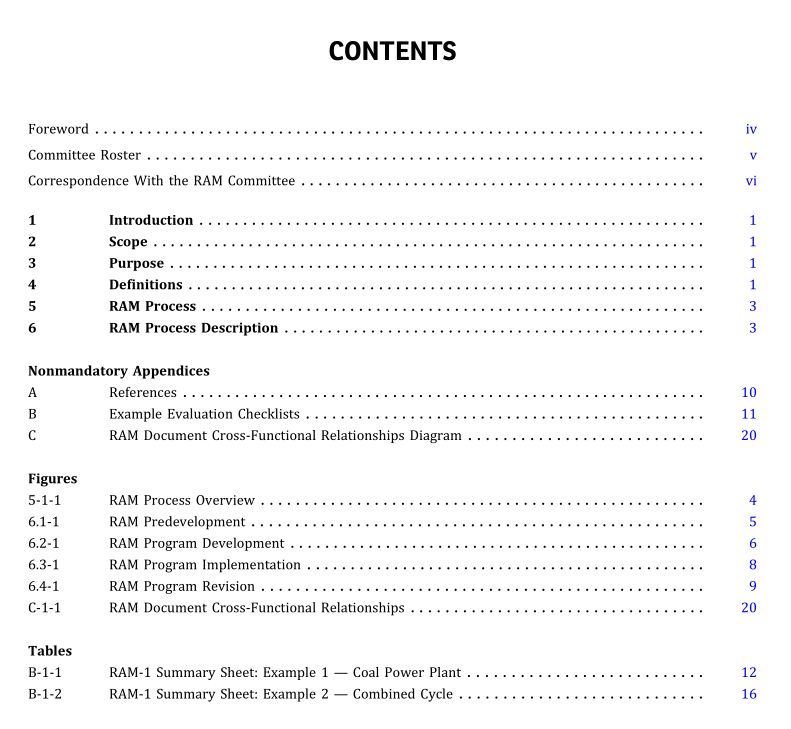ASME RAM-1 pdf download

ASME RAM-1 pdf download Reliability, Availability, and Maintainability of Equipment and Systems in Power Plants
1 INTRODUCTION
ARAM program is a structured methodologyto identify and meet the reliability, availability, and maintainability (RAM) requirements of a power plant in the most cost- effective manner. This Standard provides requirements to govern the master planning process for a power plant RAM program. It is intended to guide the develop- mentand implementation ofa comprehensive availability assurance program throughout the design, construction, and operation phases ofthe RAM project. This Standard is applicable to both new and existing facilities.
2 SCOPE
This Standard identifies the elements and responsibilities required to establish a RAM program for any powergeneration facility. The program process includes (a) establishment of RAM goals
(b) developmentofrequirements for design, construction and commissioning, and operations
3 PURPOSE
The purpose of this Standard is to meet the owner’s power plant RAM performance goals. This Standard requires the owner to determine those goals and the criteria to achieve them. To this end, it identifies program requirements that support effective reliability processes in design, construction and commissioning, and operations. It requires a risk-based approach to design and provides requirements to optimize performance effectively throughout the life cycle of the power plant.
4 DEFINITIONS availability: a measure ofthe degree to which an item is in an operable state and can be committed at the start of a mission when the mission is called for at an unknown (random) point in time; or the ability of an item to be in a state to perform a required function under given conditions, at a given instant of time or during a given time interval, assuming that the required external resources are provided.
Availability is measured by the user and is a function of how often failures occur and corrective maintenance is required, how often preventive maintenance is performed, how quicklyindicated failures can be isolated and repaired, how quickly preventive maintenancetaskscanbeperformed,andhowmuchlogis- tics support delays contribute to downtime.
basis ofdesign (BOD): the underlying assumptions and re- quirements that support the physical plant design. boundaries: the interfaces that define where each system begins and ends. For a typical plant, the boundaries include physical, mechanical, and electrical isolation physical points, e.g., isolation valves or piping locations, heatexchangertubebundleinterfaces,electricalbreakers, or switch or termination points. This Standard requires system boundaries to be defined. condition assessments:judgements usedto assess thestate ofequipmentto determine the need to perform applicable maintenance;
also called predictive activities. condition-based response: an initiative taken after a struc- ture, system, or component has failed to function in order to restore itto an acceptable condition. Also called corrective maintenance.
condition monitoring: used to trend degrading conditions of a structure, system, or component that is not readily revealed byunavailability, reliability, and plant-level indi- cators for which advance awareness of degradation is needed. Some types ofcondition monitoring are vibration characteristics, temperature, acoustics, and electrical pa- rameters.
corrective maintenance: see condition-based response criticality: the relative importance of tasks, equipment, systems, or components and their contributions to the mission. design basis: see basis ofdesign.
failure finding tests: used to assess operational capability (operability) of standby or redundant equipment. failure mode analysis (FMA): an assessment addressing how a structure, system, or component can fail; what can cause the failure;
what the likelihood of failure is; whattheconsequences offailure are; andways to mitigate thefailure.Themeansaremainlythroughdetection,main- tenance, or design redundancy. hard-time maintenance: the upkeep of equipment with known time-dependent aging characteristics. These consist primarily of explicit rework or replacement tasks. Hard time can include compound tasks that comprise equipment overhauls. Also called time-based maintenance. maintainability:
(a) theabilityofanitemtoberetainedin,orrestoredto, a specified condition when maintenance is performed by personnel having specified skill levels, using prescribed procedures and resources, at each prescribed level of maintenance and repair.









